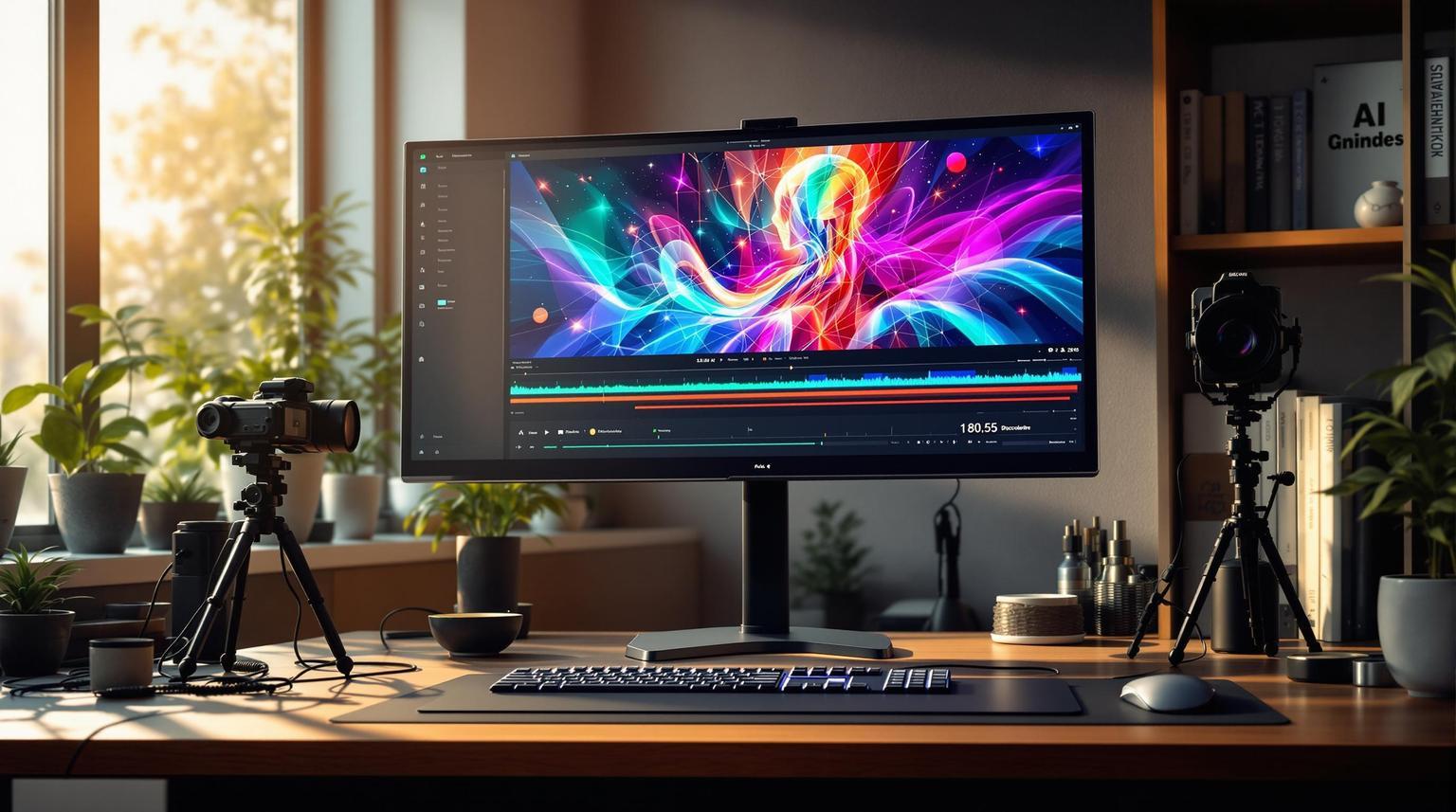
LongStories is constantly evolving as it finds its product-market fit. Features, pricing, and offerings are continuously being refined and updated. The information in this blog post reflects our understanding at the time of writing. Please always check LongStories.ai for the latest information about our products, features, and pricing, or contact us directly for the most current details.
Custom Frame Rates in AI Video Tools
Frame rates are crucial for video quality, style, and platform compatibility. AI video tools now make it easier to adjust frame rates with features like interpolation, artifact reduction, and real-time previews. Here's what you need to know:
-
Common Frame Rates:
- 24 FPS: Cinematic feel.
- 30 FPS: Standard for digital content.
- 60 FPS: Smooth motion for sports or gaming.
-
Why It Matters:
- Smooth visuals with higher frame rates.
- Match platform requirements (e.g., YouTube supports 60 FPS).
- Manage file sizes efficiently with AI compression tools.
-
Key AI Features:
- Motion analysis for frame generation.
- Tools like LongStories.ai simplify frame rate adjustments.
Frame rates impact how your video looks and performs. With AI tools, creators can easily align their videos with creative goals and platform standards.
Use AI to Boost Video's FPS for Ultra-Smoothness
Advantages of Custom Frame Rates
Custom frame rates in AI video tools provide both creative flexibility and technical precision, making them a valuable asset for AI-driven workflows.
Creating Specific Video Styles
Choosing exact frame rates allows you to achieve various visual styles effortlessly - whether it's the cinematic feel of 24 fps or the ultra-smooth motion of 60 fps. AI-powered frame interpolation simplifies these adjustments, saving time and effort.
| Content Type | Recommended Frame Rate | Visual Effect |
|---|---|---|
| Technical demonstrations | 60 fps | Smooth, precise motion |
| Slow-motion analysis | 120+ fps | Detailed movement breakdown |
High frame rates, while demanding, are now easier to handle with AI tools that streamline the process.
Meeting Platform Requirements
AI tools make it easier to match frame rates to platform-specific needs. For instance, YouTube supports 60 fps for high-quality playback, while TikTok's formats are optimized for scrolling. Real-time AI previews ensure your content aligns perfectly with these requirements.
File Size Management
AI tools also help manage file sizes without compromising quality. By combining frame rate adjustments with advanced compression methods like H.265, they achieve an ideal balance between quality and file size. Key strategies include:
- Using variable frame rate (VFR) encoding for mixed content types.
- Leveraging H.265/HEVC codecs for efficient compression.
- Balancing frame rate, resolution, and bitrate to maintain quality while reducing file size.
These features ensure your videos are optimized for both performance and storage efficiency.
Setting Custom Frame Rates
Once you've chosen the frame rate that suits your creative or technical goals, there are a few important steps to ensure smooth implementation.
Project Setup Steps
Adjusting your frame rate starts with setting up your project correctly. First, import your video file and review its original specifications.
Here’s a simple workflow to follow:
- Check the source file's details (frame rate, format, etc.).
- Set your desired frame rate based on platform requirements.
- Use AI interpolation settings to ensure smooth transitions.
This approach helps avoid errors during conversion and ensures the output matches your expectations.
Frame Rate Tools Comparison
There are several AI video tools available, each with unique strengths for frame rate adjustments. For example, Adobe Premiere Pro offers advanced frame blending, while Topaz Video AI focuses on AI-powered frame interpolation.
| Feature | Adobe Premiere Pro | LongStories.ai | Topaz Video AI |
|---|---|---|---|
| Max Frame Rate | Custom | 60 fps | Custom |
| AI Interpolation | Limited | Basic | Advanced |
| Ease of Use | Low | High | Medium |
Quality Check Process
To ensure your frame rate adjustments are up to par, it's essential to validate the output. Tools like Topaz Video AI include features like split-screen previews, allowing you to compare the original and processed footage directly.
Here are the key quality markers to watch for:
- Smooth and natural motion
- Accurate audio synchronization
- Absence of visual glitches or artifacts
- Consistent pacing throughout the video
sbb-itb-94859ad
Frame Rate Optimization Tips
Once you've set up custom frame rates, these AI-based techniques can help you get the most out of your efforts:
Performance vs Quality
Higher frame rates, like 60 FPS, can lead to larger file sizes and greater processing demands. To keep everything running smoothly:
- Balance hardware limits with your quality goals: Don’t push your system beyond its capabilities.
- Use GPU acceleration: This speeds up processing significantly.
- Keep an eye on system resources: Monitor your hardware during rendering to avoid slowdowns.
Multi-Video Processing
If you're working on projects that involve processing multiple videos, AI tools can make a big difference.
AI-driven batch processing can cut processing time by up to 50% compared to traditional methods. To make the most of it:
- Use multi-core CPUs or enable GPU acceleration to handle tasks in parallel.
- Adjust frame rates based on specific scenes for better results.
- Continuously track performance to ensure smooth processing across all files.
API Integration Options
LongStories.ai's API simplifies frame rate adjustments with automated tools and preset configurations. Here’s what it offers:
- Custom presets: Maintain consistent frame rates across projects.
- Automated quality checks: Ensure your videos meet required standards.
- Built-in error handling: Minimize disruptions during processing.
To maintain reliable results, include error handling and quality checks in your API workflow. This ensures that your frame rate adjustments are accurate and your video quality remains high.
Common Frame Rate Problems
Even with fine-tuned settings, certain frame rate issues persist and require careful handling.
Motion Artifacts
Modern AI tools can reduce motion artifacts by up to 40% compared to older methods. This is achieved through advanced interpolation techniques that help maintain the visual quality of videos.
| Issue | AI Solution |
|---|---|
| Stuttering | Smart frame distribution |
| Ghosting | Artifact detection filters |
| Judder | Adaptive frame blending |
These techniques are key to ensuring smooth playback, as discussed in the Quality Check Process.
Audio Synchronization
Adjusting frame rates often leads to audio drift, especially in longer videos. For instance, converting a video from 24fps to 30fps can result in about 1 second of audio drift every 4 minutes.
To fix this, consider these approaches:
- Time stretching: Modifies audio duration while keeping the pitch intact.
- Sample rate conversion: Aligns audio timing with the new frame rate.
- AI-based audio alignment: Automatically syncs audio during processing.
Format Issues
Video formats and codecs react differently to frame rate changes. For example, compressed formats like H.264 .mp4 files often show more artifacts after adjustments. Transcoding these files to ProRes before making changes can reduce artifacts by up to 60%.
| Format Challenge | AI Workaround |
|---|---|
| Compressed files | Automatic ProRes conversion |
| VFR sources | CFR standardization |
| Interlaced footage | Smart deinterlacing |
These AI-driven solutions are particularly helpful in animation workflows, where handling intricate movements requires precise interpolation methods.
Summary
Building on the workflow strategies discussed earlier, implementing frame rates effectively involves understanding both technical requirements and the needs of specific platforms.
Key Advantages
Using advanced interpolation techniques can maintain visual quality at higher frame rates while cutting motion blur by 50% compared to standard frame rates. As highlighted in Meeting Platform Requirements, AI tools can automatically adjust content for smooth playback across various platforms.
How to Implement
- Align frame rates with your content goals by leveraging AI tools.
- Test outputs using the quality benchmarks discussed earlier to confirm they meet the intended standards.
Stick to the validation methods outlined previously to ensure your results work well across different platforms and scenarios.
Scaling with LongStories.ai
For teams looking to expand their production capabilities, LongStories.ai enhances the API features mentioned earlier by offering:
- Analytics tailored to specific platforms for tracking performance.
- Automated presets designed to streamline large-scale production.
The Proficient Storyteller plan includes detailed performance metrics, enabling creators to make informed decisions based on audience engagement and platform-specific requirements.
FAQs
How to make an AI video smoother?
To create smoother AI-generated videos, you can use two key interpolation methods:
- Frame Blending: Ideal for static or slower-moving content. This method blends frames together to create a smooth transition.
- Motion-Based Interpolation: Best for dynamic scenes or fast animations. It analyzes pixel movement between frames, making it effective for complex visuals.
"Modern AI interpolation models can generate high-quality frames while maintaining real-time processing speeds"
Here's a quick guide to match interpolation methods with content types:
| Content Type | Recommended Frame Rate | Best Interpolation Method |
|---|---|---|
| Educational Videos | 24-30 fps | Frame Blending |
| Product Showcases | 30-60 fps | Motion-Based |
| Technical Demos | 60 fps | Advanced AI Interpolation |
| Narrative Content | 24 fps | Frame Blending |
For automated workflows, integrate these techniques with APIs (as discussed earlier) to ensure smooth and consistent results across multiple video batches.
